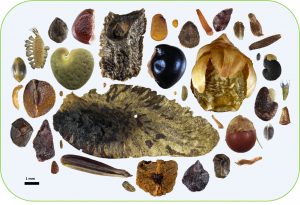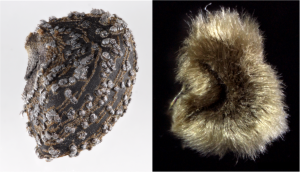Seeds come in all different sizes, from microscopic orchid seeds to tropical coconuts. Seed traits like size, shape and appendages affect how they disperse and germinate, but surprisingly little is known about the traits of Australia’s diverse seeds.
Digitising 1000 seed species
Scientists and volunteers from the Centre for Australian National Biodiversity Research (CANBR) have been busily working to change this. They have captured digital images and associated trait data for 1000 species from the National Seed Bank at the Australian National Botanic Gardens – over a quarter of the species held in the seed bank’s collection. The images cover expertly identified, verified seeds from across the entire country, including Christmas and Norfolk Islands.
These images and data are now freely available on the Australian Plant Image Index (search Class ‘nsb’ in lower case) and displayed with the species records in the Atlas of Living Australia, opening the door for scientific research, education and practical applications such as plant and seed identification guides.
“The images have been captured from verified seed specimens that are linked to plant specimens and records at the Australian National Herbarium. This is important because identifying plants from seeds and fruits alone may not be possible without also considering flowers, leaves and other plant parts,” said seed conservation biologist Dr Lydia Guja of the CANBR.

“Seed diversity is a relatively unexplored aspect of Australia’s native plants. In many cases we don’t yet know the range of variation in characteristics like texture or appendages. This is the first step in documenting trait variation so that we can begin to understand seed trait evolution, ecological function and environmental interactions,” she said.
Uncovering seed secrets
The work has uncovered some intriguing features of native seeds that prompt new ecological questions.
Noticing that seeds of some hibiscus species have a dense covering of long hairs, while other species have only residual hairs that look more like scales, the researchers speculated that extra hairs may help seeds in arid environments to collect and retain water to facilitate germination.
“We observed that species with hairier seeds occur in arid environments and those with fewer seed hairs occur in the tropics, suggesting potentially different evolutionary pathways for these species and adaptations that may allow them to survive under different environmental conditions,” said Dr Brooke Clinton of the CANBR.

Understanding seeds also has practical applications in conservation biology.
“If seed traits can help us understand the requirements of seeds, such as whether they need to be buried under the soil to germinate or will germinate successfully nearer the surface, this could help to increase the success of restoration programs and expand the number of species that can be used in such programs,” Dr Clinton said.
Inspiring scientists, teachers and artists
The team has received many requests for their seed images, including for images of edible grains used by Aboriginal people and from conservationists seeking images of threatened species to use for identification and awareness-raising. Bush Blitz is using seed images in school education programs, teachers are using the free downloadable poster A Handful of Acacia Seeds and researchers are uploading images and trait data like these into national and international plant trait databases.
The team behind the 1000 seeds project has dreamed up many possible additional uses of the images and trait data, including inspiring artists and jewellers, or searching for useful biochemicals in arils – the fleshy appendages containing proteins and oils that attract ants and birds who disperse the seeds.
Where to from here?
Volunteers at the National Seed Bank are continuing to digitise the more than 3500 species in the collection. CANBR researchers are working to uncover ecological functions and evolutionary signals from the measured seed traits and using artificial intelligence (AI) to analyse images for more rapid trait extraction.
- Australian native seeds: a digital image library was supported by funding from Bush Blitz.
- The Centre for Australian National Biodiversity Research is a joint venture between Parks Australia’s Australian National Botanic Gardens and CSIRO.